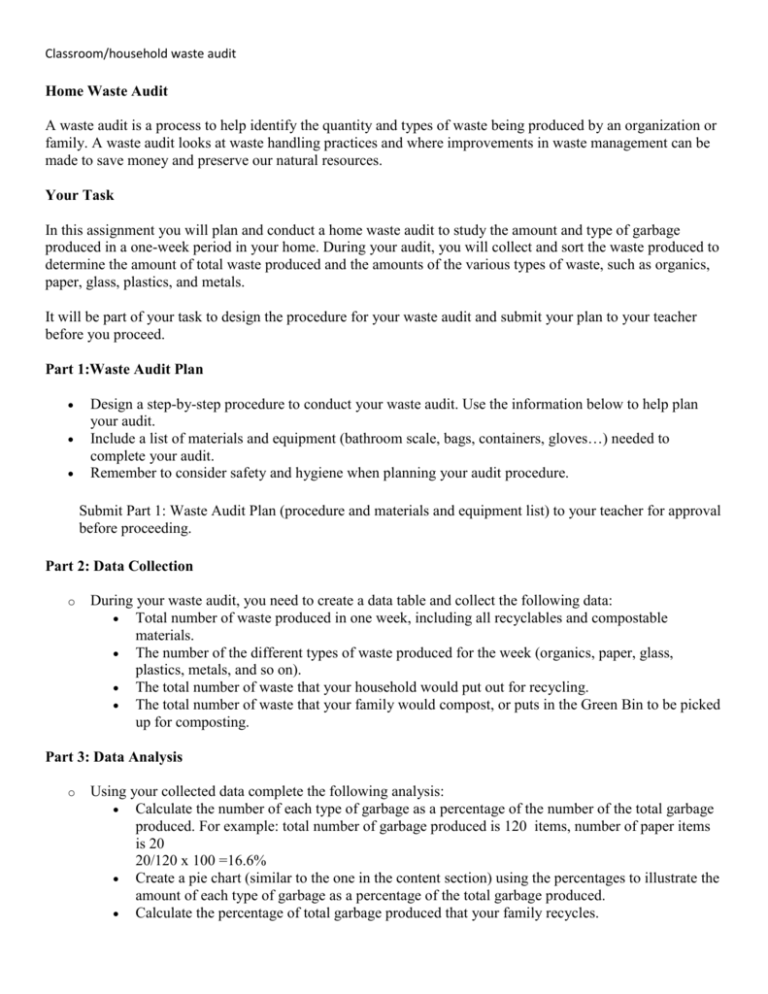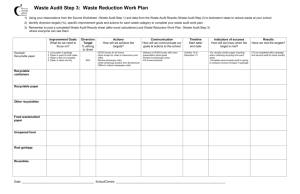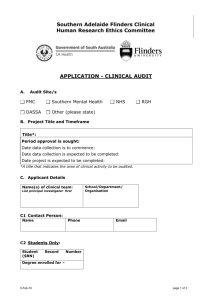Waste Audit Gr.7
advertisement

Classroom/household waste audit Home Waste Audit A waste audit is a process to help identify the quantity and types of waste being produced by an organization or family. A waste audit looks at waste handling practices and where improvements in waste management can be made to save money and preserve our natural resources. Your Task In this assignment you will plan and conduct a home waste audit to study the amount and type of garbage produced in a one-week period in your home. During your audit, you will collect and sort the waste produced to determine the amount of total waste produced and the amounts of the various types of waste, such as organics, paper, glass, plastics, and metals. It will be part of your task to design the procedure for your waste audit and submit your plan to your teacher before you proceed. Part 1:Waste Audit Plan Design a step-by-step procedure to conduct your waste audit. Use the information below to help plan your audit. Include a list of materials and equipment (bathroom scale, bags, containers, gloves…) needed to complete your audit. Remember to consider safety and hygiene when planning your audit procedure. Submit Part 1: Waste Audit Plan (procedure and materials and equipment list) to your teacher for approval before proceeding. Part 2: Data Collection o During your waste audit, you need to create a data table and collect the following data: Total number of waste produced in one week, including all recyclables and compostable materials. The number of the different types of waste produced for the week (organics, paper, glass, plastics, metals, and so on). The total number of waste that your household would put out for recycling. The total number of waste that your family would compost, or puts in the Green Bin to be picked up for composting. Part 3: Data Analysis o Using your collected data complete the following analysis: Calculate the number of each type of garbage as a percentage of the number of the total garbage produced. For example: total number of garbage produced is 120 items, number of paper items is 20 20/120 x 100 =16.6% Create a pie chart (similar to the one in the content section) using the percentages to illustrate the amount of each type of garbage as a percentage of the total garbage produced. Calculate the percentage of total garbage produced that your family recycles. Calculate the percentage of total garbage produced that your family composts or puts in the Green Bin to be picked up. Based on the number of people living in your house calculate the average number of total waste, including recyclables and compostable materials, produced per person in your house. Part 4: Conclusions and Recommendations Write a concluding paragraph summarizing your family's waste production and handling practices. Outline a short plan on how your family can reduce the amount of garbage it produces. Submit Parts 2, 3, and 4 of your Waste Audit to your teacher. Rubric View the rubric for this assignment. View the long description of the rubric for this assignment. Assignment 2 Complete the following assignment and submit your work to your teacher. Career Connect Waste management is a growing industry due to our growing population and the need to develop new ways to deal with our increasing waste production. As a result, there are a variety of jobs in the waste management field at landfill sites, wastewater treatment plants, and recycling and compost facilities. There are also numerous job opportunities transporting waste to these facilities. In this assignment you are to research a career in the waste management industry and create a Career Connect Facts Sheet that includes the information outlined below. 1. 2. 3. 4. 5. 6. 7. 8. Job title Required education and training General job description and on the job duties Working conditions (inside, outside, inside a vehicle, sitting, standing…) Potential income Positive aspects (good things) of this job Negative aspects (not so good things) of this job Two companies in Canada that hire for this type of job Rubric Categories Level 1 Waste Audit Rubric Level 2 (50 - 59%) (60 - 69%) Level 3 Level 4 (70 - 79%) (80 - 100%) - uses minimal critical thinking Thinking skills when -proposes possible proposing possible solutions to a current solutions to a practical environmental current practical problem. environmental problem. - uses some critical thinking skills when proposing possible solutions to a current practical environmental problem. - uses considerable critical thinking skills when proposing possible solutions to a current practical environmental problem. - uses a high degree of critical thinking when proposing possible solutions to a current practical environmental problem. Communication -compiles accurate data from laboratory, and organizes and records the data, using appropriate formats, including tables, and graphs. - compiles and organizes data from investigation with some accuracy and effectiveness. - compiles and organizes data from investigation with considerable accuracy and effectiveness. - compiles and organizes data from investigation with a high degree of accuracy and effectiveness. - conducts a waste - conducts a waste audit of their home audit of their home with considerable with some planning planning and and organization. organization. - conducts a waste audit of their home with a high degree of planning and organization. - applies considerable knowledge of safe laboratory practices and procedures when planning investigations. - applies a high degree of knowledge of safe laboratory practices and procedures when planning investigations. - compiles and organizes data from investigation with limited accuracy and effectiveness. - conducts a waste audit of their home Application -conducts a waste audit with limited planning and of their home. organization. Application -applies knowledge of - applies limited safe laboratory knowledge of safe practices and laboratory practices procedures when and procedures planning investigations when planning by using appropriate investigations. techniques and personal protection. - applies some knowledge of safe laboratory practices and procedures when planning investigations.







